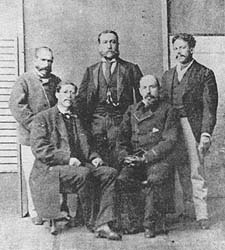In an earlier post, Novelist who loved geography set a story in Mexico, which his publisher labeled South America, we referred to Mexico’s first international scientific expedition in 1874.
This is the expedition that social historian William H. Beezley says was linked by many Mexican writers to Jules Verne’s fictional epic, Around the World in 80 Days, published the year before. (Mexican National Identity: memory, innuendo and popular culture).
Beezley’s account has one significant error; he mistakenly writes that the international expedition was to observe an eclipse of the sun, when in fact its purpose was to make measurements during a transit of Venus across the Sun. Venus only transits the sun infrequently, but then usually does so twice in eight years.
Mexico is not commonly associated with astronomy, despite the fact that archaeologists and archaeoastronomers have worked out that several indigenous groups including the Zapotec, Aztec and Maya all constructed astronomical observatories and were able to predict eclipses and other events in the skies with incredible precision. Perhaps even more remarkably, an international astronomical congress appears to have been held in Xochicalco in the 8th century BC.
We can not be certain how much the ancients knew about astronomy, but by the 18th century, British astronomer Edward Halley had worked out that if only the transit of Venus could be observed from several different places, the differences in timing could be used to calculate the precise distance of the Earth from the Sun, a distance known as the astronomical unit. Unfortunately Halley died in 1742, before he had the chance to observe the next transits of Venus in 1761 and 1769. [The most recent transit of Venus across the Sun occurred on 8 June 2004; the next is expected on 6 June 2012.]
Obtaining an accurate figure for the astronomical constant was one of the greatest challenges for astronomers of the time. In 1760, a French astronomer set out for India (for the 1761 transit) but failed to arrive in time! Undeterred, he remained in India, waiting patiently for 1769. Alas, on that occasion it was too cloudy to make any worthwhile observations.

Left to right: Jiménez, Barroso, Díaz Covarrubias, Fernández Leal, Bulnes (Photo reproduced in Odisea 1874)
Mexico’s connection to the astronomical constant began at this time. For the 1769 transit, Spain had granted permission to another French astronomer to join a party of Spanish astronomers setting up a temporary observatory near San José del Cabo on the southern tip of the Baja California peninsula. A short distance away, a creole astronomer Joaquín Velázquez de León had traveled from Mexico City to make independent observations. Only days after the transit, three members of the Franco-Spanish party, including the two principal astronomers, died of yellow fever.
By the time of the next transit in 1874, large scientific teams had been assembled by several countries including France, Russia, Germany and the USA to collect better data for a more accurate calculation of the astronomical constant.
Mexico had a fledgling astronomy community, but decided it must send a team to Yokohama, Japan. The team consisted of:
- Francisco Díaz Covarrubias (the expedition’s leader) who had written various books and had installed the first post-Independence astronomy observatory in Chapultepec Castle, Mexico City, in 1863.
- Francisco Jiménez – whose offical qualification was as a “geographic engineer”. He had fought in defense of Chapultepec Castle when the USA invaded in 1847, written about the 1769 transit, and been a key member of the Mexican Border Commission which fixed the definitive Mexico-USA boundary in 1856. He helped coordinate research for the great map of Mexico produced by Antonio García Cubas. Jiménez was the first person to use telegraph signals to determine longitudes in Mexico with precision.
- Francisco Bulnes was the expedition’s chronicler and the youngest member of the team.
- Agustín Barroso had wide interests in natural science and engineering, and became an early enthusiast of photogaphy and its applications to astronomy. He was responsible for the outstanding sequence of photos of the transit of Venus taken as part of the Mexican scientific expedition’s work.
- Manuel Fernández Leal was an expert surveyor and educator who had also participated on the Mexican Border Commission.
The team traveled to Japan and were able to make valuable measurements. Commendably, they published their first results very much more quickly than did the astronomers from all other countries.
Mexico’s scientific community has continued to play an active part in major international research ever since. See for example, our earlier post about Mexicans involved in the work of the Inter Intergovernmental Panel on Climate Change (IPCC). Scientific globalization was under way…
Source: Odisea 1874 o el primer viaje internacional de científicos mexicanos by Marco Arturo Moreno Corral (Fondo de Cultura Económica, 1986)
Sorry, the comment form is closed at this time.